I have been, or can be if you click on a link and make a purchase, compensated via a cash payment, gift, or something else of value for writing this post. As an Amazon Associate, I earn from qualifying purchases. Please read my full Affiliate Disclosure for more information.
Ever dreamed of transforming a tiny outdoor space into a lush, vibrant retreat? Small garden designs have become incredibly popular because they prove that even the tiniest patches can be filled with personality, color, and natural charm. These compact gardens are perfect for urban dwellers, homeowners with limited yard space, or anyone eager to create a peaceful oasis without the hassle of vast maintenance.
With clever ideas and thoughtful touches, your small garden can feel just as inviting and lively as a sprawling landscape. In this article, you’ll find a treasure trove of inspiration and practical tips to elevate your small garden into a vibrant sanctuary.
From charming pathways and rustic planters to colorful accents and eco-friendly decor, each idea is designed to maximize style and functionality. Whether you’re looking to add a cozy nook, a splash of color, or a touch of artistry, these design ideas will help you craft a natural, lively retreat tailored to your space and personality. Get ready to turn your small garden into a stunning, vibrant haven!
1. Incorporate Natural Stone Pathways for Organic Flow
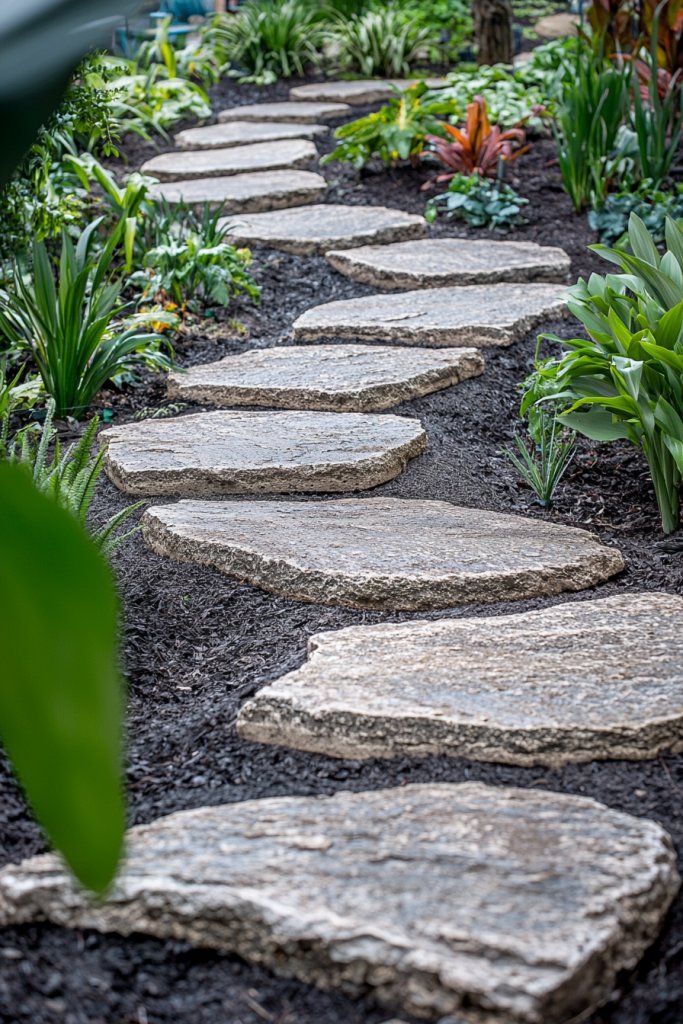
Creating winding stone pathways is a simple yet impactful way to bring an organic, natural flow to your small garden. These pathways guide visitors through the space, inviting exploration and adding visual interest.
Recommended Products to replicate this idea
| # | Preview | Product | |
|---|---|---|---|
| 1 |

|
Sekcen 3 Pack Rubber Stepping Stones Outdoor Garden Rubber Pavers Pathway Walkway Paving Stones | Check Latest Price |
| # | Preview | Product | |
|---|---|---|---|
| 1 |

|
Qualdout River Rocks Stepping Stones Pavers Outdoor for Garden Walkway, Pebbles Polished Gravel... | Check Latest Price |
When designed thoughtfully, they seamlessly blend with the surrounding greenery, making the garden feel larger and more cohesive. Imagine a gently curving path made of irregularly shaped flagstones in earthy tones—warm tans, soft browns, or subtle greys—that appear to have naturally settled into the landscape.
The stones are set into a bed of fine gravel or soil, with moss or tiny ground cover plants filling in the gaps, providing lush texture and a soft, earthy scent. The path’s undulating shape creates a relaxing rhythm, encouraging slow walks and mindful enjoyment of your outdoor retreat.
The tactile contrast between the rough stone and the soft plants adds sensory richness, making the space both visually and physically inviting. To implement this, start by sketching a rough layout of your pathway, emphasizing gentle curves.
Gather natural flagstones or gravel—alternatively, recycled concrete pavers or crushed stone can work for a budget-friendly option. Dig a shallow trench along your design, lay a weed barrier fabric to keep weeds out, and then set your stones or fill the pathway with gravel, leveling as you go.
Finish by planting ground covers or low-growing plants along the edges to soften the borders and enhance the organic feel. This project is straightforward for DIY enthusiasts and transforms small gardens into tranquil, meandering escapes.
2. Use Rustic Wooden Planters and Raised Beds
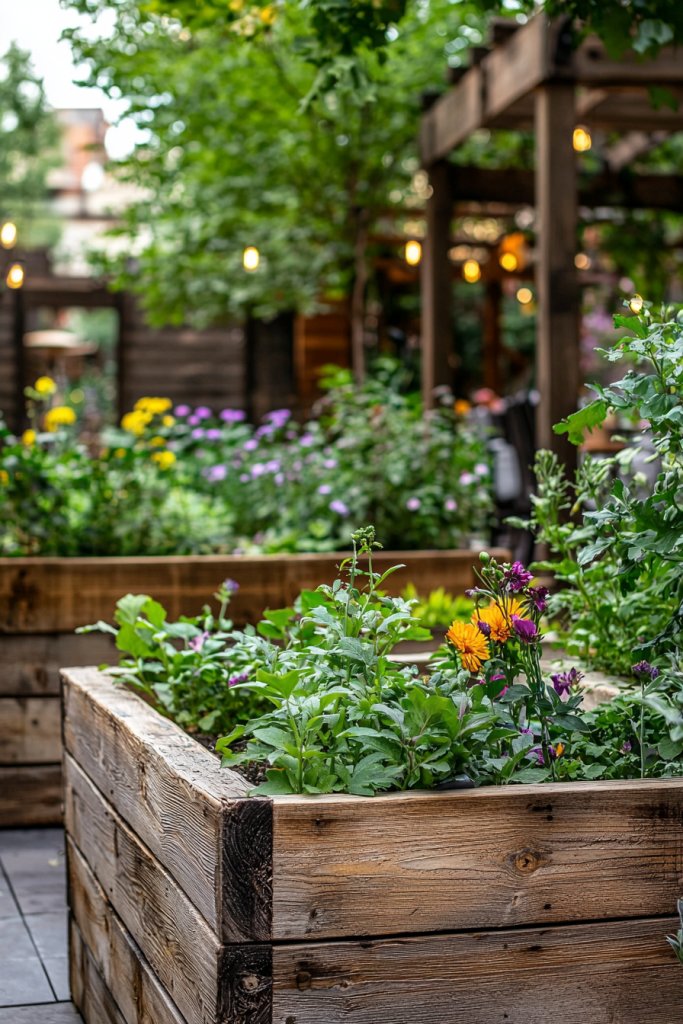
Rustic wooden planters and raised beds instantly add warmth and charm to a small garden, creating cozy, defined spaces for your plants while elevating the overall aesthetic. Weathered wood lends a natural, vintage vibe that complements a lush, vibrant landscape, making even the smallest garden feel inviting and thoughtfully designed.
Recommended Products to replicate this idea
| # | Preview | Product | |
|---|---|---|---|
| 1 |

|
LDAILY Raised Garden Bed, Outdoor Rectangle Flower Beds with Bottom Panels & 2 Drainage Holes,... | Check Latest Price |
| # | Preview | Product | |
|---|---|---|---|
| 1 |

|
Land Guard Galvanized Raised Garden Bed Kit, Galvanized Planter Garden Boxes Outdoor, Oval Large... | Check Latest Price |
Picture a compact corner with a series of reclaimed wood planters filled with colorful blooms—bright pink geraniums, cheerful yellow marigolds, or fragrant herbs. The wood’s textured surface, with its knots and grain, adds tactile interest and a sense of history.
Raised beds made from distressed pine or cedar define planting zones while giving height variation, which makes the space feel layered and more expansive. The arrangement encourages a relaxed, cottage-like atmosphere, especially when complemented by soft burlap or linen drapes draped over nearby seating areas.
The natural scent of aged timber, combined with fresh soil and blooming flowers, creates a sensory haven. Getting started is easy: select reclaimed or weathered wood—consider sourcing from salvage yards or repurposing old pallets.
Build simple rectangular or square planters using basic tools, lining the inside with landscape fabric to protect the wood from rot. Fill with rich compost, then plant your favorite flowers, herbs, or small vegetables.
Position your planters strategically to create cozy corners or visual focal points. With minimal effort and materials, you can craft a charming, rustic garden space that feels both personal and inviting.
3. Install Vertical Garden Walls with Recycled Materials
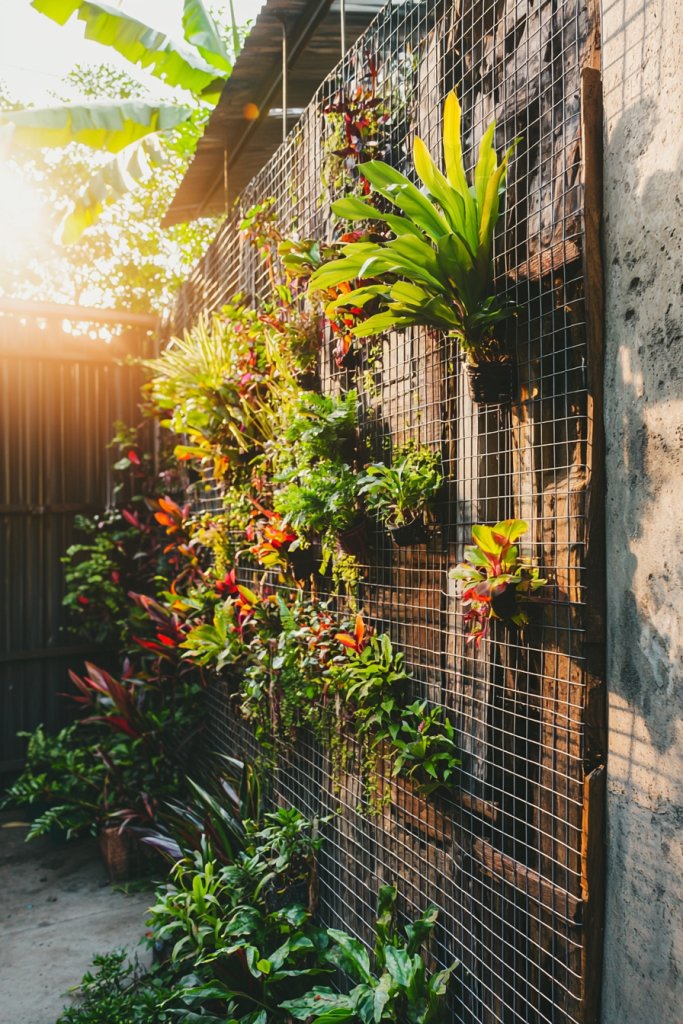
Maximize limited space by installing vertical garden walls that turn bare walls or fences into lush, vibrant living displays. Using recycled materials like reclaimed wood or metal grids, these walls add texture, color, and a sense of natural abundance to small gardens, transforming vertical surfaces into thriving green art.
Recommended Products to replicate this idea
| # | Preview | Product | |
|---|---|---|---|
| 1 |

|
Reclaimed Wood Pallet Sign Blank -DIY Art - Made in the USA (12x18) | Check Latest Price |
| # | Preview | Product | |
|---|---|---|---|
| 1 |

|
RCZSCBK 1-Pack Grid Wall Panels, 2' X 5.5' Ft Gridwall Panel Display Stand, Heavy Movable... | Check Latest Price |
Visualize a weathered wooden pallet leaned against a fence, filled with small potted plants, trailing vines, or succulents. Alternatively, a metal grid mounted on a wall provides a structural framework for hanging lightweight planters or attaching cascading plants like ivy or jasmine.
These living walls burst with color—deep greens, fiery reds, and sunny yellows—creating a lush backdrop that feels both lively and soothing. The textured layers of reclaimed wood or metal contrast beautifully with the softness of the plants, adding visual interest.
As the plants grow and cascade, they soften hard surfaces, making your small garden feel more expansive and immersive. To create your own vertical garden, start by choosing a reclaimed wood pallet, metal grid, or lattice panel.
Secure it on a sturdy wall or fence, then attach small containers or plant directly into the structure. Use lightweight pots or fabric pockets for easy maintenance and watering.
Fill with a variety of climbing plants, herbs, or succulents suited to your climate. Regular watering and pruning will keep your vertical garden thriving and vibrant, turning a small outdoor space into a lush, green sanctuary with minimal footprint.
4. Add Vibrant Outdoor Textile Accents
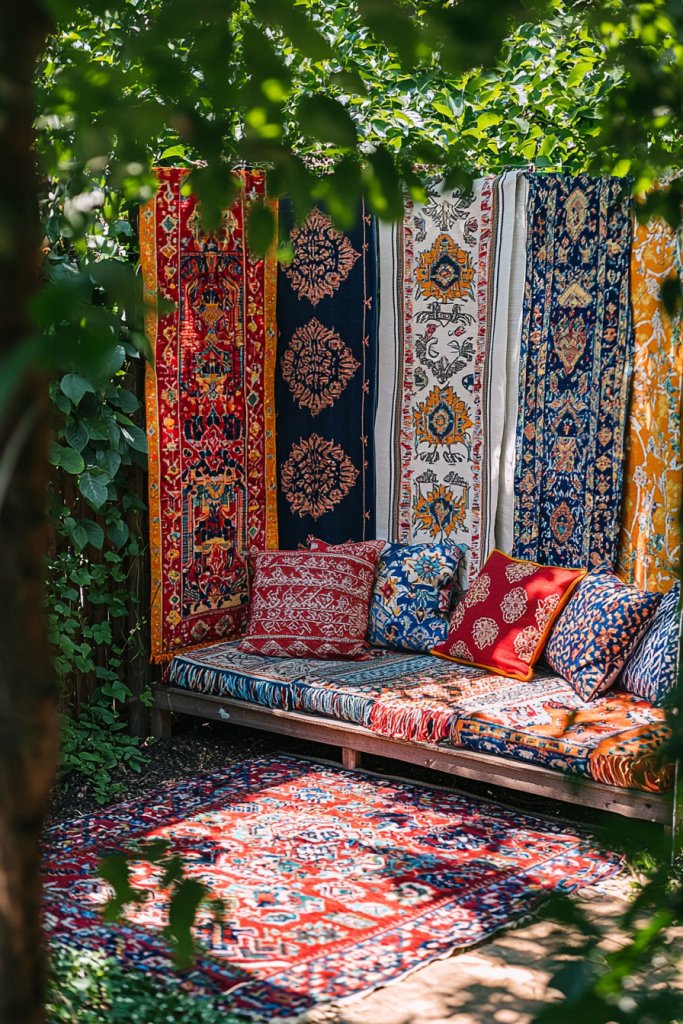
Introducing colorful outdoor textiles—rugs, cushions, and curtains—can instantly energize your small garden with lively patterns and inviting textures. These accents add personality, comfort, and a sense of coziness, transforming your garden into a vibrant outdoor living room.
Recommended Products to replicate this idea
| # | Preview | Product | |
|---|---|---|---|
| 1 |

|
SAND MINE Waterproof Outdoor Rug 5x8 ft, Plastic Reversible Rug, Modern Area Rug, Large Floor Mat... | Check Latest Price |
| # | Preview | Product | |
|---|---|---|---|
| 1 |

|
Summsun Outdoor Chair Cushions Set of 4, Waterproof Backrest and Deep Seat Cushion Set for Patio... | Check Latest Price |
Picture a small patio area with a bright, patterned outdoor rug in bold reds and blues, topped with plush cushions in contrasting shades and textures—perhaps a soft cream throw with chunky knit or a vibrant yellow pillow. Flowing curtains in lightweight linen or cotton, hung from a simple tension rod or pergola, flutter gently in the breeze, adding movement and a touch of softness.
These textiles not only introduce pops of color but also create tactile layers that beckon you to sit, relax, and linger. The combination of patterns, textures, and colors enhances the visual richness and makes your small garden feel playful and welcoming.
To implement, choose weather-resistant fabrics designed for outdoor use—think acrylic or polyester blends. Select bold patterns or bright hues that complement your overall garden palette.
Place a small, woven outdoor rug in a central seating nook, add cushions on benches or chairs, and hang lightweight curtains for shade and privacy. For budget-friendly options, repurpose old textiles or sew your own cushions using outdoor fabric. These easy-to-update accents make your garden lively and inviting, perfect for casual gatherings or quiet afternoons.
5. Incorporate Sculptural Decorative Objects

Adding sculptural decorative objects—such as artistic statues, pebbled ornaments, or natural-themed sculptures—injects personality and visual intrigue into your small garden. These pieces serve as focal points or accents that elevate the overall aesthetic and evoke a sense of retreat and artistry.
Recommended Products to replicate this idea
| # | Preview | Product | |
|---|---|---|---|
| 1 |

|
MININOVA Garden Statues Rabbit with Solar Lantern Outdoor Bunny Figurines Decorations for Patio... | Check Latest Price |
| # | Preview | Product | |
|---|---|---|---|
| 1 |

|
Nacome Solar Garden Outdoor Statues Turtle with Succulent and 7 LED Lights - Lawn Decor Tortoise... | Check Latest Price |
Imagine a small garden corner featuring a weathered stone owl perched on a pedestal, or a modern metal sculpture resembling abstract leaves nestled among flowers. Natural-themed statues—like a carved wooden fox or a smooth pebble arrangement—bring a tactile, earthy quality that complements the greenery.
These decorative objects create visual interest, draw the eye, and add a layer of storytelling to your space. Their textures and forms contrast with plants and textiles, enriching the sensory experience and making your garden uniquely yours.
To incorporate these elements, select artistic sculptures or ornaments that reflect your style—whether rustic, modern, or whimsical. Look for durable materials like stone, metal, or weather-resistant resin suitable for outdoor conditions.
Place larger objects as focal points in open areas, and scatter smaller pieces among flowers or along pathways. Regularly clean or reposition your sculptures to refresh the visual rhythm. These sculptural accents turn a simple garden into an expressive, personal retreat that invites exploration and admiration.
6. Create a Cozy Nook with a Small Seating Area

Imagine stepping into a tiny, inviting corner of your garden where you can unwind and feel completely at peace—that’s the magic of creating a cozy seating nook. This idea transforms a small outdoor space into a personal retreat, perfect for reading, chatting, or simply soaking up nature’s beauty.
Recommended Products to replicate this idea
| # | Preview | Product | |
|---|---|---|---|
| 1 |

|
Best Choice Products Outdoor Bench 2-Person Wicker Garden Patio Benches Seating Furniture for... | Check Latest Price |
| # | Preview | Product | |
|---|---|---|---|
| 1 |

|
danpinera Outdoor Side Tables, Weather Resistant Steel, Small Round End Table for Patio Yard... | Check Latest Price |
It’s all about turning a corner into a sanctuary that beckons you to relax. Visualize a compact seating area nestled beneath a flowering magnolia or surrounded by lush greenery.
Picture a weatherproof rattan loveseat or a pair of vintage-style metal chairs topped with plush cushions in soft, neutral tones—think warm beige or cool slate gray. Drape a chunky-knit throw over the armrest for added texture and comfort, and place a small, rustic side table nearby for your favorite drink or a lantern.
Surround the space with potted herbs or trailing vines, adding to the intimate, natural vibe. The scent of fresh foliage and the gentle rustling of fabric in the breeze enhance the sense of tranquility.
To bring this cozy nook to life, start with weatherproof seating such as wicker or metal furniture—both durable options. Add cushions made from outdoor fabric, like Sunbrella, in calming shades or subtle patterns.
Enhance comfort with a soft throw blanket, perhaps a chunky knit in cream or taupe. Place the furniture on a simple outdoor rug—jute or woven coir work well—and set up a small side table.
Finish with some decorative lanterns or string fairy lights overhead for evening ambiance. All materials can be sourced from garden centers or home décor stores, with DIY tutorials available online to guide your arrangement.
7. Use Multi-Functional Furniture for Space Optimization
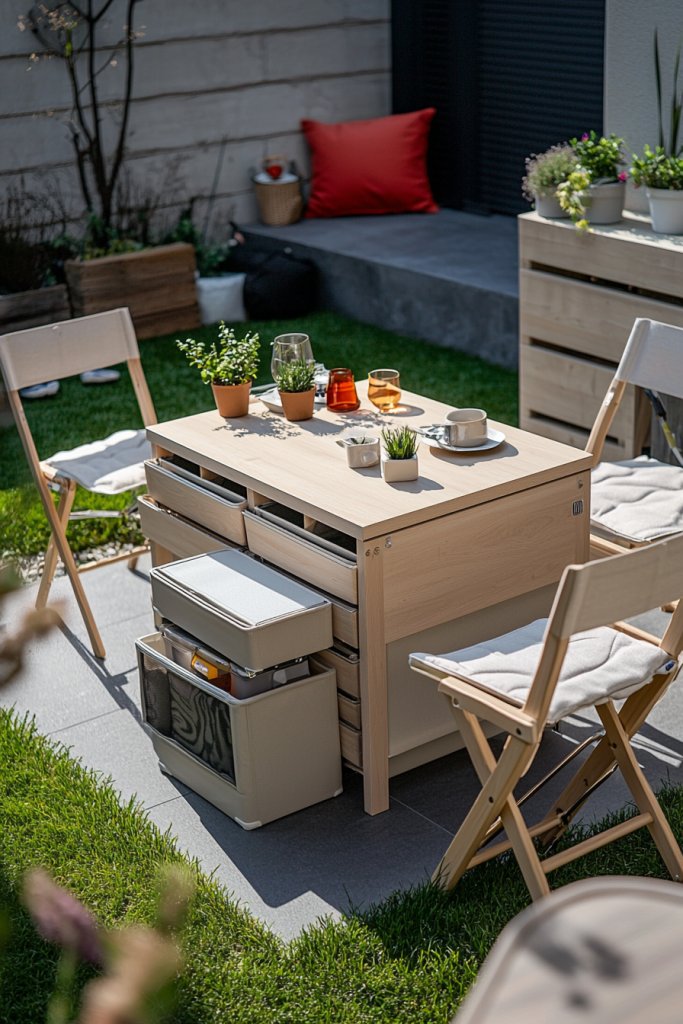
In a small garden, every inch counts, and versatile furniture is your best friend for maximizing space. Multi-functional pieces combine style and practicality, offering storage, seating, or table space without cluttering your yard.
This approach keeps your garden looking tidy, while providing everything you need for relaxation and entertainment. Visualize a sleek storage bench that doubles as seating, with a lid that lifts to reveal space for garden tools, cushions, or outdoor toys.
Or imagine a foldable table that can be expanded when hosting friends or tucked away when not in use, freeing up space for movement. Stackable chairs or stools can be neatly stored when not needed, and some models even incorporate hidden compartments for extra storage.
The overall look remains clean and streamlined, with materials like weatherproof wood, resin, or metal in neutral tones that blend seamlessly with garden surroundings. These pieces often come in contemporary or rustic styles, complementing various garden aesthetics.
To implement this idea, choose storage benches or fold-away tables made from durable, weather-resistant materials such as teak, resin, or galvanized steel. Look for options with built-in storage compartments or simple stacking features—these are beginner-friendly and widely available online or at garden centers.
Incorporate cushions or seat pads made from outdoor fabric to make the seating more comfortable. For tables, opt for lightweight, foldable designs that can be easily stored or moved. This way, your garden remains functional and inviting, no matter how you choose to use the space.
8. Implement Layered Lighting with Solar Lanterns and String Lights

Adding layered lighting transforms your small garden into a magical, inviting space after sunset. It’s about creating a warm, ambient glow that highlights your favorite features and makes the area usable during evening hours.
Recommended Products to replicate this idea
| # | Preview | Product | |
|---|---|---|---|
| 1 |

|
addlon 54(48+6) FT Solar String Lights Waterproof,Patio Lights Solar Powered with Remote & USB... | Check Latest Price |
| # | Preview | Product | |
|---|---|---|---|
| 1 |

|
KOOPER 4 Pack Solar Lantern Outdoor Lights, Upgraded Flickering Flame Solar Lanterns Lights... | Check Latest Price |
Proper lighting also enhances safety and mood, making your garden feel like a natural extension of your home. Picture strings of fairy lights or globe-shaped solar lanterns hanging overhead, casting a gentle, twinkling light across your garden.
Solar-powered lanterns with warm-yellow bulbs can be placed along pathways or on tables, while small stake lights can illuminate flower beds or borders. Imagine the soft glow reflecting off textured surfaces like stone or ceramic pots, adding depth and visual interest.
The combination of strings, lanterns, and stake lights creates a layered effect that is both functional and enchanting. The scent of night-blooming plants and the subtle hum of insects add to the sensory experience, making your garden a nighttime retreat.
To achieve this, start with solar string lights—easy to install and energy-efficient—by hanging them along fences, pergolas, or trees. Add solar lanterns or stake lights at strategic points to light pathways and highlight plants.
Choose warm white bulbs for a cozy atmosphere or multicolored options for a playful vibe. These items require minimal wiring or electricity, making installation simple and DIY-friendly.
Arrange the lights to create focal points and ensure they are positioned to cast gentle light without blinding. With a few affordable, weatherproof options, you can create a stunning, layered lighting scheme that makes your small garden glow with charm after dark.
9. Introduce Colorful Ceramic or Terracotta Pots
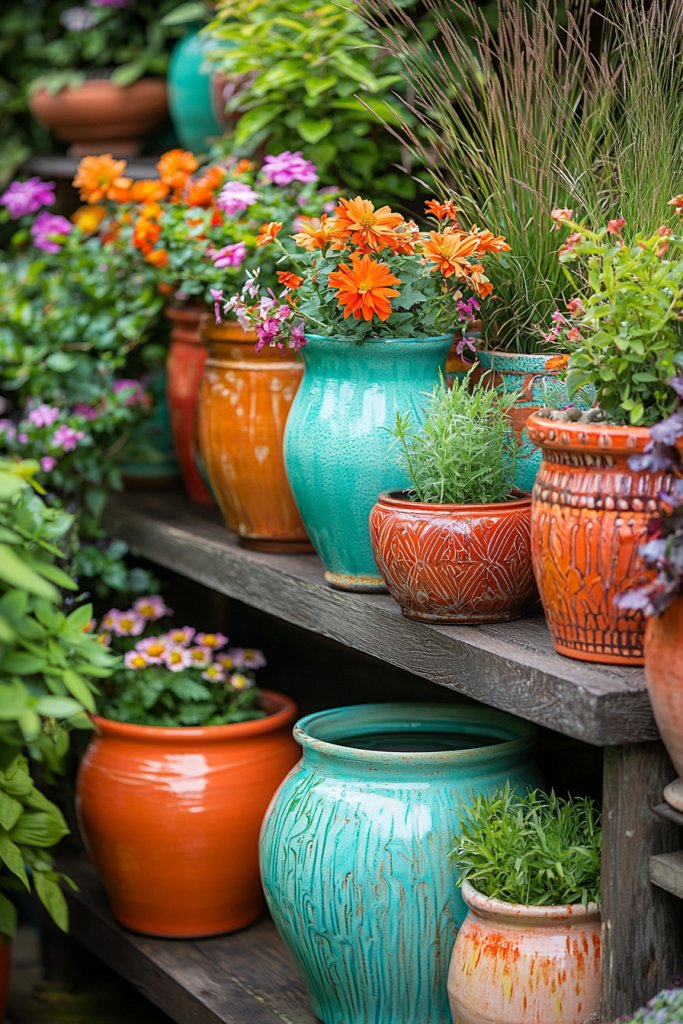
Brighten up your garden with vibrant ceramic or terracotta pots filled with seasonal blooms or ornamental grasses. These pots add pops of color, texture, and personality to any small space, making your garden feel lively and welcoming.
Recommended Products to replicate this idea
| # | Preview | Product | |
|---|---|---|---|
| 1 |

|
Gepege 6 Inch Beaded Ceramic Planter Set of 2 with Drainage Hole and Saucer for Plants,... | Check Latest Price |
| # | Preview | Product | |
|---|---|---|---|
| 1 |

|
6 inch Terracotta & Clay Pots for Plants with Saucer, Medium Terra Cotta Plant Pots with Drainage... | Check Latest Price |
Their bold hues and handcrafted appearance can serve as focal points or charming accents throughout your outdoor retreat. Imagine a cluster of pots in shades of turquoise, mustard, or deep red, arranged on a rustic wooden table or nestled among greenery.
Fill them with cheerful petunias, marigolds, or trailing ivy, with their colors contrasting beautifully against the earthy tones of terracotta. For a more modern look, choose sleek, glazed ceramics in vibrant colors, or go for textured, handcrafted pots for a more rustic feel.
The tactile quality of these pots, combined with the bright floral displays, creates a joyful, inviting atmosphere that encourages lingering and exploration. The scent of fresh soil and blooming flowers completes the sensory experience, making your garden a colorful haven.
To recreate this look, select ceramic or terracotta pots in various sizes and colors—these are widely available at garden centers or home décor stores. Fill them with seasonal plants or grasses like ornamental millet or fountain grass for height and movement.
Group the pots together to form eye-catching arrangements or scatter them around seating areas for visual interest. For added durability, you can choose glazed or weatherproof finishes. This simple yet impactful idea brings instant color and personality to your small garden, with minimal effort and maximum visual impact.
10. Design a Mini Water Feature with Recycled Materials
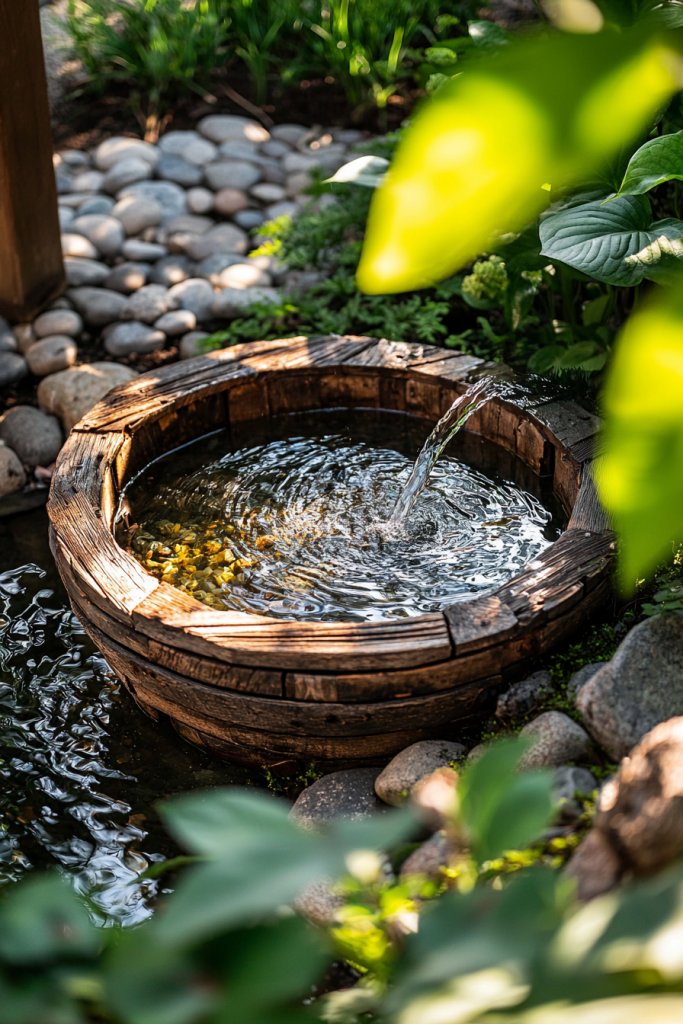
A charming mini water feature crafted from recycled materials can instantly transform your small garden into a tranquil oasis. Not only does it introduce soothing sounds and movement, but it also highlights your eco-friendly mindset while adding a unique focal point to your outdoor retreat.
Recommended Products to replicate this idea
| # | Preview | Product | |
|---|---|---|---|
| 1 |

|
Aquastrong Sump Pump 1 HP 4500 GPH Submersible Water Pump Thermoplastic Portable Utility Pump... | Check Latest Price |
| # | Preview | Product | |
|---|---|---|---|
| 1 |

|
1 LB Penny Round Mosaic Tiles, 10mm ~20mm 5sizes Iridescent Rounds Recycled Glass Tiles Mix for... | Check Latest Price |
Imagine a petite fountain made from upcycled clay pots, old metal buckets, or repurposed ceramic bowls nestled among colorful pebbles and smooth river stones. The water gently trickles over the edges, creating a calming ripple that invites you to pause and breathe.
Surrounding the feature, vibrant mosaic tiles or recycled glass pieces add shimmering accents, while the soft scent of fresh water mingles with the earthy aroma of natural mulch. The overall scene exudes rustic charm with a touch of whimsy, blending natural textures with vibrant pops of color to evoke a sense of peaceful seclusion.
Getting started is simpler than you might think. Gather some recycled containers like large teacups, metal tins, or old basins—anything waterproof and visually appealing.
Position them on a stable base, such as a flat stone or small bricks, and line the interior with waterproof sealant if needed. Fill the container with water, add decorative gravel or colorful glass pieces, and place a small submersible pump inside to circulate the water smoothly. With just a few basic materials and a bit of creativity, you can craft a charming water feature that elevates your garden’s natural beauty while staying eco-conscious.
11. Incorporate Natural Fiber Textiles for Soft Accents
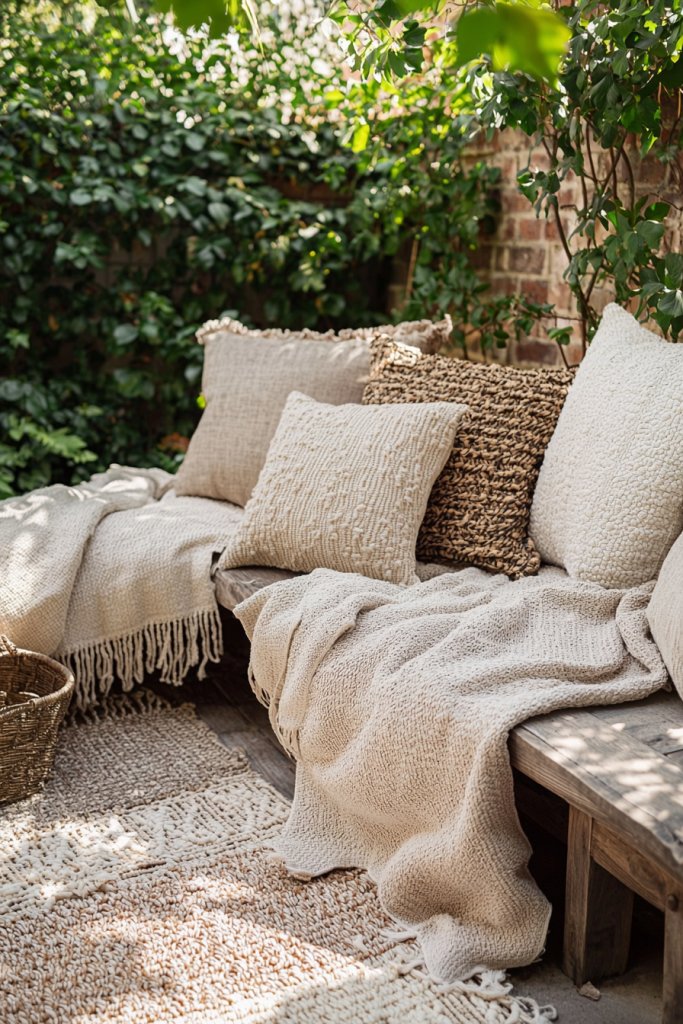
Adding natural fiber textiles introduces warmth and tactile comfort to your small garden, transforming it into a cozy retreat. These soft accents can soften hard surfaces and create inviting zones where you want to linger, making your outdoor space feel more relaxed and personal.
Recommended Products to replicate this idea
| # | Preview | Product | |
|---|---|---|---|
| 1 |

|
S & L Homes Jute Cotton Hand Woven Natural Farmhouse Area Rug for Living Room - Rustic Vintage... | Check Latest Price |
| # | Preview | Product | |
|---|---|---|---|
| 1 |

|
Outdoor Chair Cushions Set of 4: Waterproof & Fade Resistant Patio Furniture Cushions - 17L x 16W... | Check Latest Price |
Picture a sun-dappled corner with a woven jute rug underfoot, its earthy tones—a warm beige or moss green—complementing the greenery around. Cushions made from burlap or linen in neutral or muted shades rest on weatherproof benches or chairs, their textured surfaces inviting touch.
A hammock or woven mats can sway gently in the breeze, adding a laid-back vibe. These textiles introduce natural patterns and tactile warmth, making your garden feel like an extension of your living room, with sensory-rich textures and subtle earthy aromas from natural fibers.
They enhance the visual appeal while encouraging relaxation. To incorporate these textiles, start by choosing durable, weather-resistant options like burlap, jute, or hemp cushions, rugs, or throws.
Lay a small woven mat near your seating area or drape a burlap curtain on a lattice or trellis for a soft boundary. For added comfort, include a hammock swing made of woven cotton or polyester blend. These elements are easy to source from garden centers or online, and they require minimal maintenance—simply shake off dirt or spot clean as needed, making your outdoor space both beautiful and practical.
12. Create a Wildflower or Native Plant Border
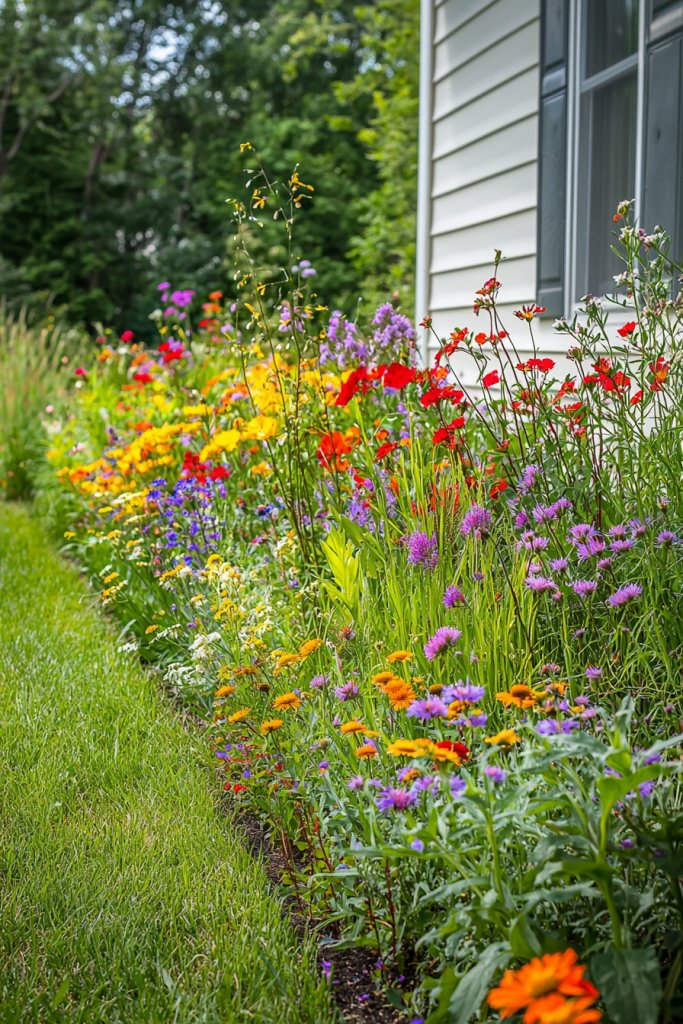
Designing a wildflower or native plant border frames your small garden with spontaneous, colorful charm while supporting local ecosystems. This low-maintenance approach adds natural beauty and vibrancy, giving your space a relaxed, untamed feel that invites butterflies, bees, and other pollinators.
Imagine a gently curved border filled with an array of wildflowers—purple coneflowers, yellow coreopsis, and bright blue lupines—interspersed with native grasses that sway in the breeze. The border appears organic, with plants growing in a seemingly unplanned but harmonious pattern, creating a lively tapestry of colors and textures.
This border blends seamlessly into the surrounding landscape, offering a natural transition from lawn to garden. It’s a visual feast of soft, flowing forms and vibrant hues, evoking a sense of wild nature captured in a small, manageable space.
Getting started is straightforward: select native or wildflower seed mixes suited to your climate, or plant a variety of perennials like Black-eyed Susans, blanketflowers, or yarrow. Use simple garden edging—such as stones or logs—to define the border, and enrich the soil with compost before planting.
Maintain by watering during dry spells and removing invasive weeds, but overall, this border thrives with minimal intervention. It’s a sustainable, eye-catching way to add color, texture, and ecological benefits to your small garden.
13. Use Bright Outdoor Art and Murals
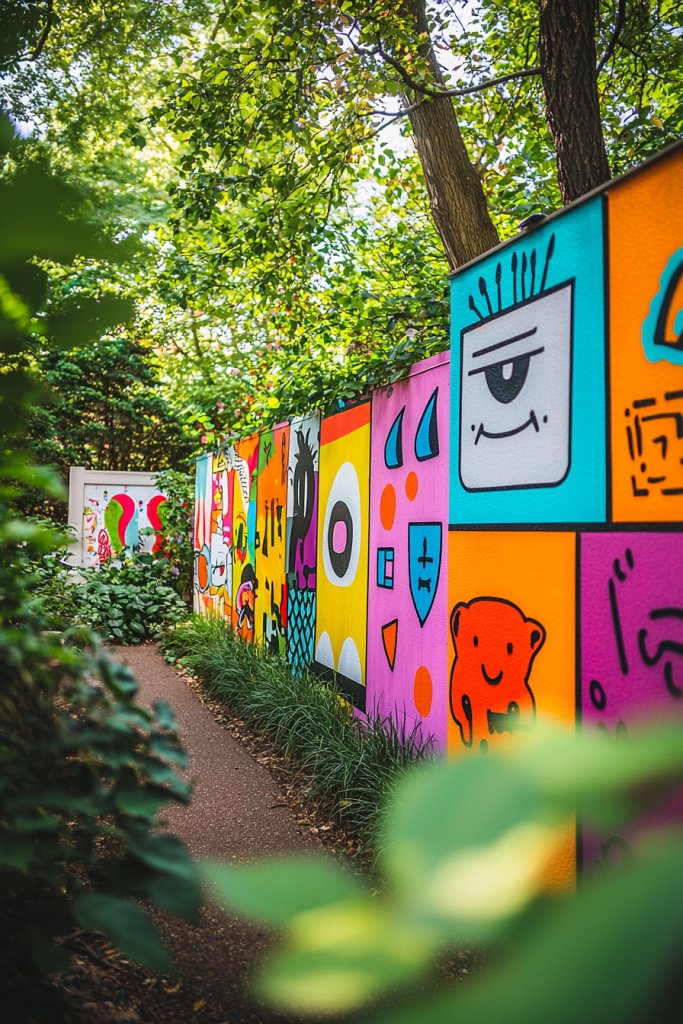
Decorating your small garden with bright outdoor art and murals infuses personality and vibrant energy into the space, making it feel uniquely yours. Colorful murals or cheerful sculptures turn plain fences or walls into focal points, transforming your garden into an artistic haven.
Recommended Products to replicate this idea
| # | Preview | Product | |
|---|---|---|---|
| 1 |

|
CSFOTO 7x16ft Big Tree Garage Door Banner - Spring Garden Scenery Wallpaper - Nature Park Plant... | Check Latest Price |
| # | Preview | Product | |
|---|---|---|---|
| 1 |

|
GIFTME 5 Metal Garden Sculptures Statues Yard Art Decoration,Set of 4 Garden Decor Perfect... | Check Latest Price |
Visualize a weather-resistant mural painted directly on a garden wall—perhaps a lively floral scene in bold reds, yellows, and blues, or an abstract design with swirling patterns. Alternatively, hang colorful, durable outdoor art pieces such as metal sculptures, mosaic panels, or painted ceramic plaques that catch the sunlight and add visual interest.
Brightly painted garden gnomes, metal butterflies, or whimsical wind chimes can also contribute playful pops of color. These elements create a lively, joyful atmosphere, making your small garden feel cheerful and inviting, even from a distance.
To implement, choose weatherproof paints or materials designed for outdoor use. For murals, sketch your design beforehand on paper or use stencils for precision, then paint directly on a clean, primed surface.
For sculptures and art pieces, select durable materials like powder-coated metal, glazed ceramics, or mosaic tiles. Position these art elements thoughtfully—near seating areas or along pathways—to maximize their visual impact. Regular cleaning and occasional touch-ups will keep your garden looking vibrant and fresh.
14. Arrange Compact Edible Garden Elements
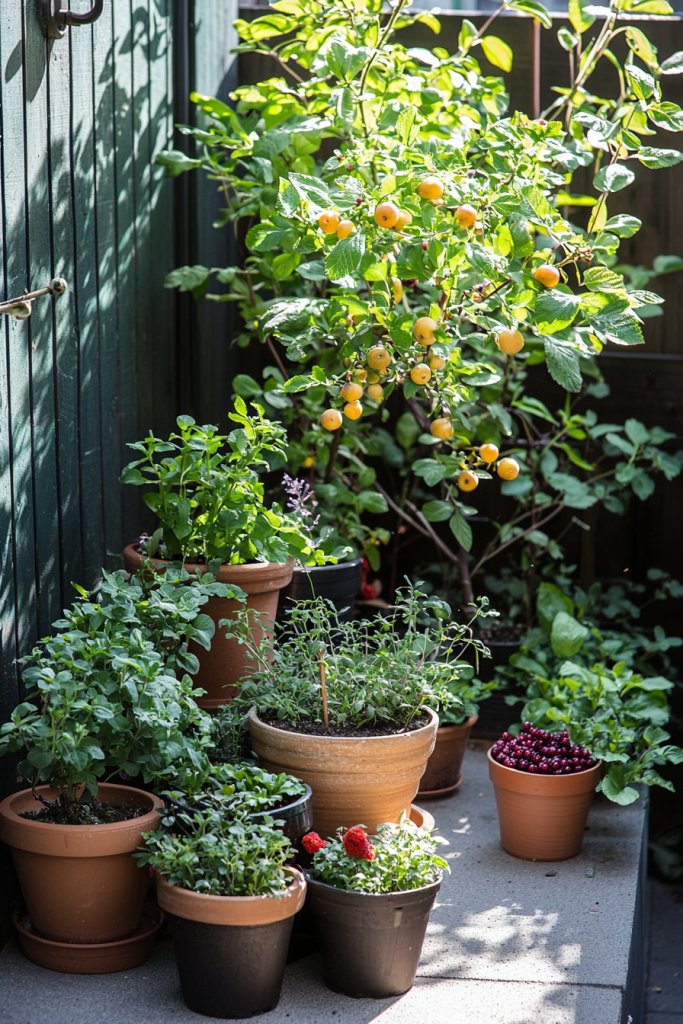
Incorporating small, functional edible garden elements makes your tiny outdoor space both beautiful and practical. Growing herbs, compact fruit trees, or berry shrubs adds a lively, homegrown touch that excites the senses and encourages sustainable living.
Recommended Products to replicate this idea
| # | Preview | Product | |
|---|---|---|---|
| 1 |

|
KIBAGA Beautiful Herb Garden Planter Indoor Set of 3 - Perfect for Any Kitchen Window Sill or... | Check Latest Price |
| # | Preview | Product | |
|---|---|---|---|
| 1 |

|
The Easiest Dwarf & Container Fruit Tree Gardening Handbook For Beginners 2025: How to Grow Fruit... | Check Latest Price |
Imagine a corner with a set of stacked herb planters filled with basil, thyme, and mint, their fragrant leaves filling the air. Nearby, a potted citrus tree in a decorative container offers bright, glossy leaves and fragrant blossoms, while a small berry bush like raspberries or blueberries provides bursts of color and flavor.
Arrange these elements along a narrow pathway or within a dedicated bed, blending practicality with visual appeal. The mix of lush greenery, colorful fruits, and aromatic herbs creates a lively, sensory-rich environment that’s perfect for cooking or simply enjoying nature’s bounty.
Start by selecting compact, container-friendly varieties suited to your climate—such as dwarf citrus or compact berry plants. Use decorative pots in vibrant colors or natural textures like terracotta or ceramic, which can be easily moved and rearranged.
Plant herbs in tiered or vertical planters to save space. Water regularly, harvest often, and enjoy the satisfaction of picking fresh ingredients daily. This approach adds vitality to your garden while offering the joy of homegrown produce in a small footprint.
15. Employ Natural Mulches and Ground Covers
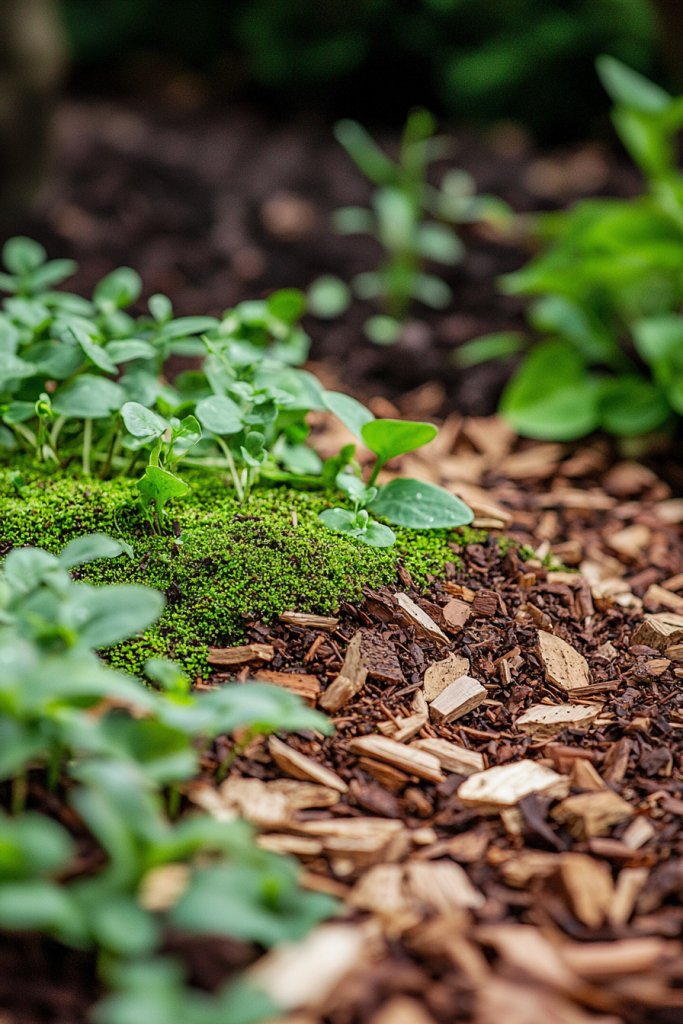
Using natural mulches and ground covers enhances your small garden’s beauty while providing functional benefits like weed suppression and moisture retention. These layers add texture and a cohesive, lush appearance that ties everything together.
Recommended Products to replicate this idea
| # | Preview | Product | |
|---|---|---|---|
| 1 |

|
100% Natural Pine Bark Mulch Nuggets (12 Quarts), Small Chips for Indoor/Outdoor Container... | Check Latest Price |
| # | Preview | Product | |
|---|---|---|---|
| 1 |

|
40 LBS Grey Pea Gravel - Landscape Rocks - Drainage Rock - Gardening - Average Size 3/8 inch -... | Check Latest Price |
Picture a garden bed with a thick layer of bark mulch in warm browns, contrasting with the vibrant green of plants and flowers. Alternatively, a spread of gravel or pea shingle in soft grays creates a sleek, modern look along pathways or around decorative features.
Moss or low-growing ground covers like Creeping Jenny or Irish moss can blanket shaded areas with velvety green, softening the overall aesthetic. These coverings help define different zones, reduce maintenance, and give your garden a well-tended, polished feel.
They also add tactile variation, inviting gentle touches and visual interest. To implement, choose the appropriate mulch for your climate and style—bark for a natural look, gravel for modern appeal, or moss for shaded areas.
Prepare the soil by removing weeds and loosening it, then spread a consistent layer of your chosen mulch or ground cover. For organic mulches, replenish as needed to maintain their appearance and effectiveness. These simple additions significantly improve garden health and visual cohesion, making your small garden a vibrant, tidy retreat with minimal effort.
16. Incorporate Reclaimed Furniture with a Vintage Charm
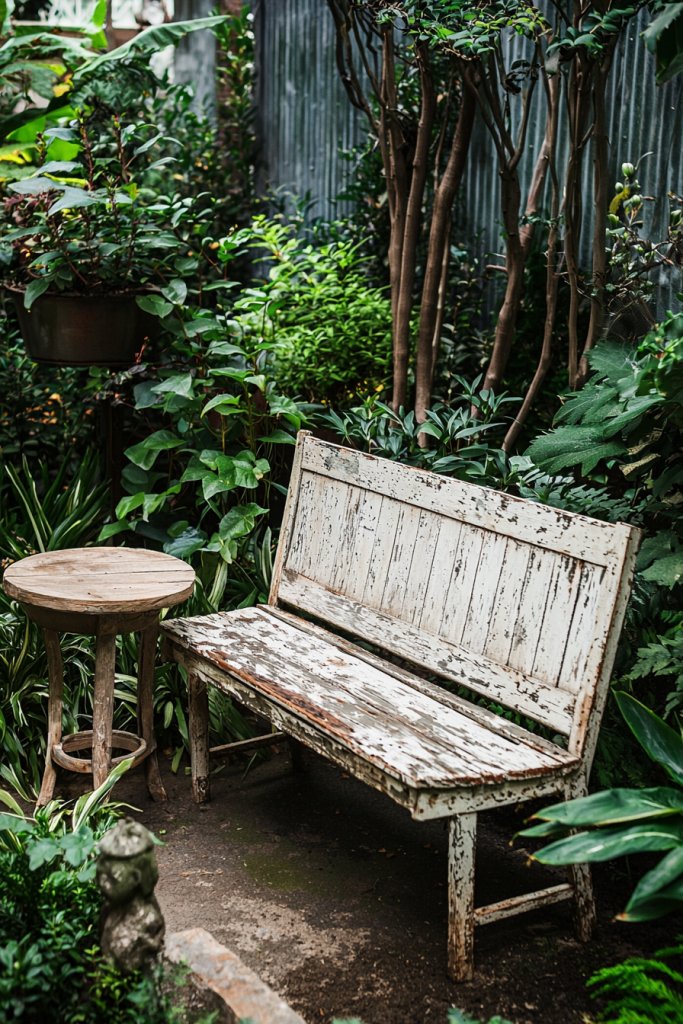
Adding reclaimed furniture brings a warm, nostalgic feel to your small garden, transforming it into a charming vintage retreat. It’s a sustainable choice that infuses character and history into your outdoor space, making it feel uniquely yours.
Recommended Products to replicate this idea
| # | Preview | Product | |
|---|---|---|---|
| 1 |

|
Giantex Outdoor Wooden Garden Bench - 2-Person Acacia Wood Loveseat with Armrests, Backrest,... | Check Latest Price |
| # | Preview | Product | |
|---|---|---|---|
| 1 |

|
EKNITEY 2 Tier End Table - Metal Side Table Waterproof Small Sofa Coffee Side Tables Bedroom... | Check Latest Price |
This approach is perfect for creating a cozy, lived-in vibe that encourages relaxation and storytelling. Imagine a weathered wooden bench with peeling paint, paired with a vintage metal side table and a rustic, distressed garden armchair.
These pieces, often featuring imperfect textures and muted, earthy tones like soft creams, faded blues, or mossy greens, create a layered, inviting atmosphere. They blend seamlessly with lush greenery and colorful floral accents, adding visual interest and a sense of timelessness.
The tactile mix of rough wood, cool metals, and soft cushions invites touch and comfort, making the space feel warm and welcoming. To recreate this look, start by sourcing vintage or reclaimed furniture from thrift stores, online marketplaces, or salvage yards.
Focus on sturdy, weather-resistant materials—think teak, wrought iron, or reclaimed pine—that can withstand outdoor conditions. Lightly sand or clean the pieces to remove dirt and splinters, then apply a weatherproof sealant if necessary.
Mix and match different styles to enhance the eclectic charm, and add cushions or throws in cozy textiles like burlap or rough linen for extra comfort. With a little patience, your garden will boast a timeless, inviting character that’s both sustainable and stylish.
17. Design a Hidden Corner with Privacy Screens
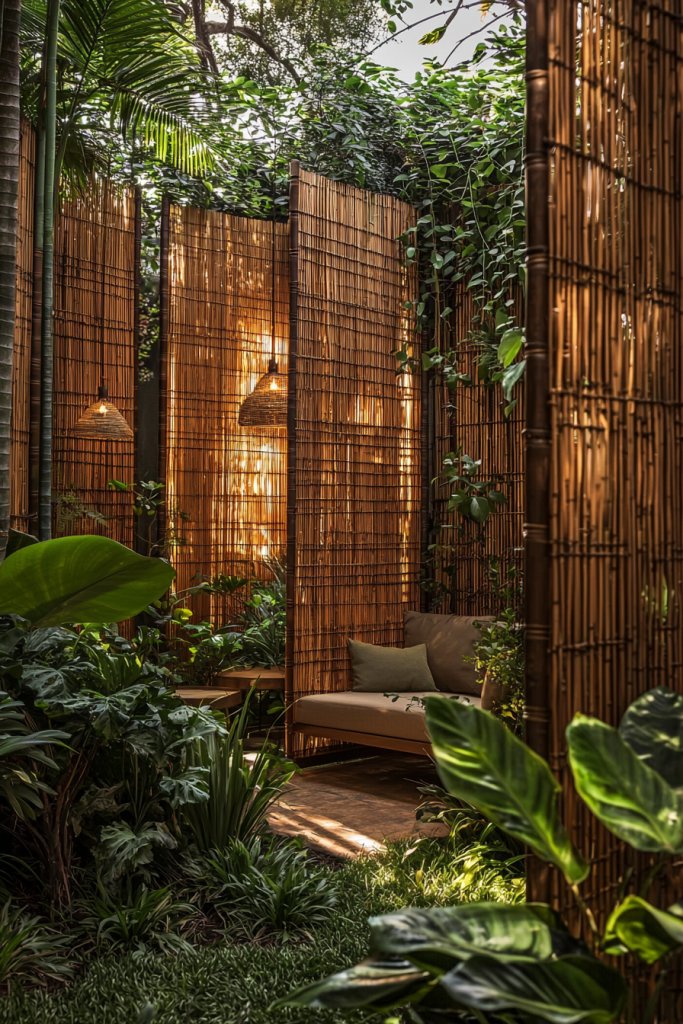
Creating a secluded nook in your small garden offers a peaceful escape from everyday noise and distractions. Privacy screens made from natural materials help define this intimate space, providing a tranquil retreat that feels both cozy and protected.
Recommended Products to replicate this idea
| # | Preview | Product | |
|---|---|---|---|
| 1 |

|
3 Panels No Dig Wooden Privacy Fence Screen, 42" H X 40" W Outdoor Air Conditioner Fences, Hide... | Check Latest Price |
| # | Preview | Product | |
|---|---|---|---|
| 1 |

|
GCI OUTDOOR Freestyle Rocker Outdoor Rocking Chair with Beverage Holder | Check Latest Price |
This idea transforms an overlooked corner into a personal sanctuary perfect for reading, relaxing, or enjoying a quiet moment. Visualize a corner tucked behind a tall lattice panel covered in climbing vines, with a cozy outdoor armchair or a small bench nestled underneath.
Surrounding the space are bamboo poles or weathered wooden panels, creating a natural barrier that filters sunlight and muffles external sounds. String lights or lanterns can be hung overhead, casting a soft glow that enhances the sense of seclusion.
The area might feature a small side table with a ceramic cup or a textured woven rug, adding tactile warmth and visual appeal. Overall, this hidden corner feels like a secret garden, inviting you to unwind and reconnect with nature.
To build this retreat, start by selecting a corner of your garden that offers natural privacy or can be easily enclosed. Use bamboo fencing, lattice panels, or reclaimed wood trellises as the primary screening material—these are affordable, eco-friendly, and blend beautifully with outdoor environments.
Grow climbing plants like clematis or jasmine on the screens for extra greenery and fragrance. Position a comfortable outdoor chair, a small table, and soft outdoor cushions or throws in weatherproof fabrics to complete the space. With minimal effort, you’ll craft a private, peaceful haven perfect for quiet mornings or evening chats, adding a magical touch of retreat to your garden.
18. Use Colorful Lanterns and Fairy Lights for Evening Charm
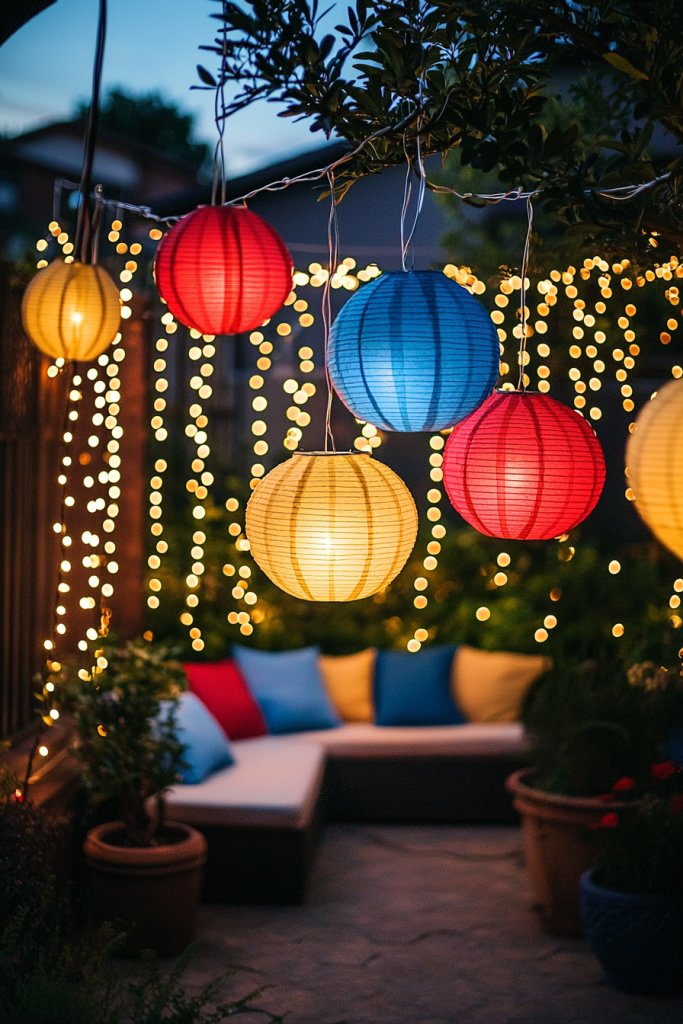
Transforming your small garden into a magical evening oasis is easy with the right lighting. Colorful lanterns and fairy lights add a whimsical, vibrant glow that elevates the space after sunset, making it perfect for outdoor gatherings, quiet evenings, or simply enjoying the night sky.
This soft illumination enhances the garden’s ambiance, creating a warm and inviting atmosphere. Picture strings of tiny LED fairy lights draped along trellises, woven through bushes, or hung from tree branches, twinkling like stars.
Brightly colored paper or glass lanterns in hues like amber, turquoise, or coral hang from hooks or poles, casting a gentle, diffused light that highlights garden features and textures. The combination of warm, colorful glows and delicate string lights can make the space feel enchanted, playful, and cozy.
As night falls, the garden transforms into a vibrant, dreamy retreat where you can relax, entertain, or simply enjoy the serenity. To achieve this look, start by choosing weather-resistant solar-powered fairy lights and colorful lanterns that suit your style and budget.
String the lights across focal points like pergolas, fences, or trees, ensuring they’re securely fastened. Place larger lanterns on tables or the ground in strategic spots to add depth and visual interest.
Opt for LED lights to save energy and ensure longevity. The key is layering different types of lighting at varying heights and colors to create a dynamic, festive atmosphere. With a few simple steps, your garden will glow with charm and vibrancy well into the evening hours.
19. Add Textured Decorative Gravel or Pebbles

Incorporating textured gravel or pebbles adds a tactile dimension to your small garden, creating visual interest and defining different zones with ease. These materials introduce natural patterns and soothing textures that complement plantings and other decorative features.
Recommended Products to replicate this idea
| # | Preview | Product | |
|---|---|---|---|
| 1 |

|
YISZM 2LB Succulent and Cactus Gravel Pebbles, 1/5 Inch Natural Decorative Polished Stones, River... | Check Latest Price |
| # | Preview | Product | |
|---|---|---|---|
| 1 |

|
Natural Pebble Stepping Stones for Garden & Outdoor Walkways - 9 Inch Round Therapeutic Massage... | Check Latest Price |
Their versatility makes them a practical and stylish way to enhance your outdoor space. Imagine a pathway lined with smooth, rounded pebbles in shades of gray, cream, or terracotta, winding gently through lush greenery.
Or envision a decorative bed filled with coarse, colorful gravel—perhaps in earthy reds, browns, or blues—that contrasts beautifully with soft moss or ornamental grasses. The tactile quality of gravel and pebbles invites touch, while their varied textures add depth and movement to the landscape.
They also serve practical purposes, such as preventing weed growth and improving drainage. Overall, textured gravel elevates the garden’s aesthetic, making it feel more layered, natural, and engaging.
To implement this idea, choose gravel or pebbles suited to your design—smooth river stones, crushed granite, or decorative colored gravel. Measure the areas you want to cover, then purchase enough material to create a layer approximately 2-3 inches thick.
Prepare the space by removing existing grass or soil, leveling the ground, and installing a weed barrier fabric to prolong the visual appeal. Spread the gravel evenly and rake it into place.
For added visual interest, mix different colors or sizes of gravel, and consider framing the beds with bricks or wooden borders for a polished look. This simple yet effective technique brings texture and definition to your garden, making it more inviting and dynamic.
20. Incorporate Eco-Friendly, Recycled Garden Decor
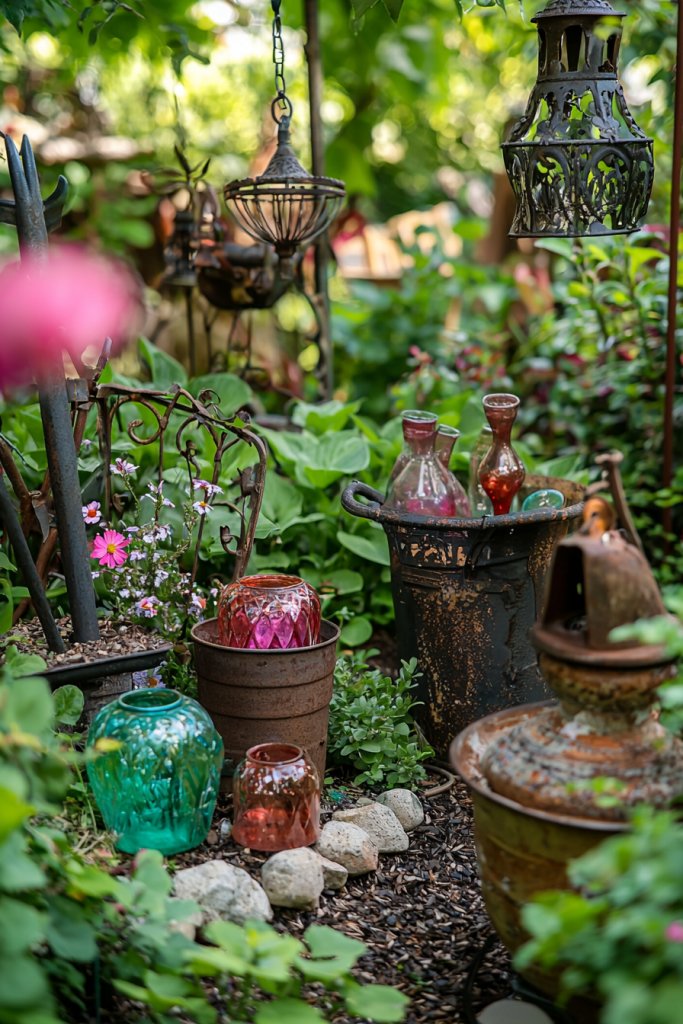
Adding eco-friendly, recycled garden decor gives your small garden a distinctive, sustainable charm while reducing waste. Upcycled containers, repurposed metal objects, and recycled glass pieces can serve as decorative accents that showcase creativity and environmental consciousness.
Recommended Products to replicate this idea
| # | Preview | Product | |
|---|---|---|---|
| 1 |

|
Tablecraft Oil & Vinegar Serving Bottle with Pourer, 12 oz, Green | Check Latest Price |
| # | Preview | Product | |
|---|---|---|---|
| 1 |

|
Alpine Corporation 11" Tall Outdoor Metal Wide-Eyed Bird Standing Yard Statue Decoration, Multicolor | Check Latest Price |
This approach infuses your space with personality and encourages eco-friendly practices. Visualize a garden corner decorated with colorful glass bottles repurposed as lanterns or bird feeders, a vintage metal watering can turned into a planter, and a collection of painted terracotta pots made from reclaimed materials.
Scatter small sculptures made from reclaimed metal scraps or natural materials like driftwood and stones, creating focal points that spark curiosity. These elements add texture, color, and a story to your garden, making it uniquely yours while promoting sustainability.
The overall aesthetic feels eclectic, vibrant, and thoughtfully curated, emphasizing your commitment to eco-conscious living. To incorporate recycled decor, start by exploring thrift stores, flea markets, or online marketplaces for vintage or discarded items suitable for garden use.
Clean and, if needed, restore or repaint pieces to match your style. Use recycled glass bottles, metal scraps, or upcycled containers as planters, lighting, or decorative accents.
Securely position these items in your garden, ensuring they’re stable and weather-resistant. Incorporate a variety of textures and colors for visual interest, and consider creating DIY projects—like turning old pallets into plant stands. This sustainable decorating approach not only beautifies your garden but also supports environmental responsibility, making your outdoor space a reflection of eco-friendly creativity.
21. Create a Small, Inviting Entryway with Artistic Gateways
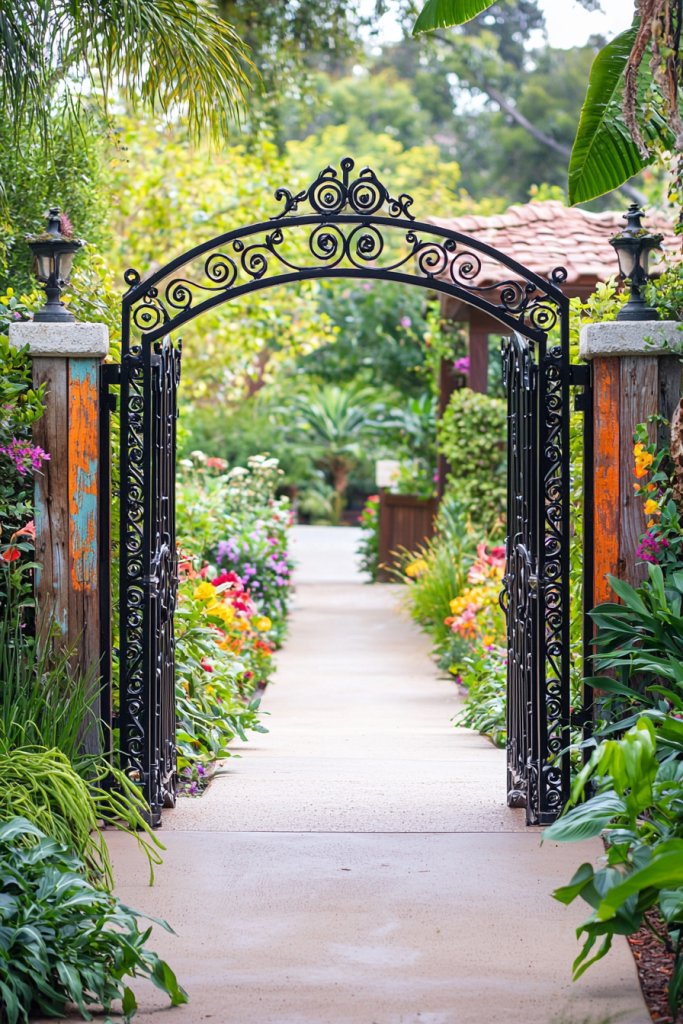
A charming entryway sets the tone for your entire garden, inviting visitors to step into a vibrant, natural retreat. An artistic gateway can transform a plain fence or path into a captivating focal point that sparks curiosity and warmth right from the start.
Recommended Products to replicate this idea
| # | Preview | Product | |
|---|---|---|---|
| 1 |

|
RUBFAC 94" Metal Garden Arch Trellis for Climbing Plants Outdoor, Garden Arbors and Arches,... | Check Latest Price |
| # | Preview | Product | |
|---|---|---|---|
| 1 |

|
addlon 54(48+6) FT Solar String Lights Waterproof,Patio Lights Solar Powered with Remote & USB... | Check Latest Price |
Imagine a handcrafted archway made from reclaimed wood, painted in soft pastel hues or left in weathered, natural tones. Decorate it with hanging lanterns or string fairy lights for a magical glow at dusk.
Flanking the gateway with lush, cascading climbers like clematis or jasmine adds texture and a fragrant welcome. Incorporate decorative elements such as wrought iron details or mosaic tiles for added personality, blending artistry with nature.
The pathway leading through the gateway can be lined with colorful stepping stones or gravel, creating a seamless transition from the outside world into your peaceful garden sanctuary. To recreate this inviting entrance, start by choosing a sturdy, weather-resistant frame—an old metal or wooden arch works well.
Secure it in place at your garden’s edge or along a walkway. Decorate with string lights or hanging ornaments, and plant climbers or vines to grow up and around the structure over time.
For an extra touch, add a small, decorative sign or plant pots filled with seasonal blooms nearby. Use affordable materials like reclaimed wood, solar-powered fairy lights, and durable outdoor paint to keep costs down. With a little effort, you’ll craft a warm, welcoming entry that instantly elevates your small garden’s charm and character.
Conclusion
With these diverse small garden design ideas, you have everything you need to transform your outdoor space into a vibrant, natural retreat. From incorporating natural materials and layered lighting to creating cozy nooks and lively borders, each concept offers a way to personalize and energize your garden.
Don’t hesitate to experiment and blend these ideas to craft a unique oasis that reflects your style and spirit. Start today—your perfect small garden awaits!
Last update on 2025-09-21 / Affiliate links / Images from Amazon Product Advertising API
Leave a Reply